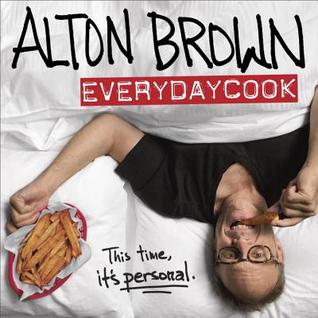Search the Blog
Categories
- Books & Reading
- Broadband Buzz
- Census
- Education & Training
- Friday Reads
- General
- Grants
- Information Resources
- Library Management
- Nebraska Center for the Book
- Nebraska Libraries on the Web
- Nebraska Memories
- Now hiring @ your library
- Preservation
- Pretty Sweet Tech
- Programming
- Public Library Boards of Trustees
- Public Relations
- Talking Book & Braille Service (TBBS)
- Technology
- Uncategorized
- What's Up Doc / Govdocs
- Youth Services
Archives
Subscribe
Tag Archives: Friday Reads
Friday Reads: Ms. Bixby’s Last Day by John David Anderson
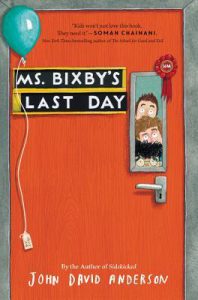 I am a boy-mom. (Or at least I was until we welcomed a baby girl into our house almost 2 years ago. 2?!? How is she almost 2? Wait… where was I? Ah, yes, boys.) I am inclined to fall in love with realistic fiction centered on boys, probably because I can see my own son living these adventures and learning those early-life lessons. I felt especially enamored recently with the 3 friends that narrate Ms. Bixby’s Last Day. Topher, Steve, and Brand are 6th graders, finishing out their last year of elementary school.
I am a boy-mom. (Or at least I was until we welcomed a baby girl into our house almost 2 years ago. 2?!? How is she almost 2? Wait… where was I? Ah, yes, boys.) I am inclined to fall in love with realistic fiction centered on boys, probably because I can see my own son living these adventures and learning those early-life lessons. I felt especially enamored recently with the 3 friends that narrate Ms. Bixby’s Last Day. Topher, Steve, and Brand are 6th graders, finishing out their last year of elementary school.
Ms. Bixby is one of those rare teachers that is a “Good One”. She has a pink streak in her hair and spouts endless inspiring quotes, or “Bixbyisms”. She sees what’s special in each of her students and helps them to see it too. But Ms. Bixby suddenly takes ill and can’t finish the school year. When she has to miss her good-bye party at school, our three heroes decide to skip school and take the party to her in the hospital.
Each boy’s perspective colors the nature of their scheme. Topher, the artist and story-teller, is playing out a military-grade mission in his mind. Brand is determined to do for Ms Bixby what he never could do for his own injured father. And Steve is just worried about how much trouble he’s going to be in for ditching school.
Their quest is fraught with peril, as good adventures are wont to be, and the boys find themselves, and their friendship, put to the test. Will they be able to give Ms. Bixby the last day she deserves? It’s an incredibly moving story, both laugh-out-loud funny at times, and sob-inducing at others. This boy-mom highly recommends!
Anderson, John David (2016). Ms. Bixby’s Last Day. New York: Walden Pond Press.
Friday Reads: The Motion of Puppets by Keith Donohue
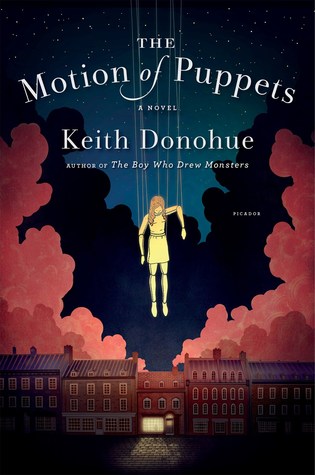 A newly married couple move to Quebec for the summer where Kay works as an acrobat while Theo translates a French biography on Eadweard Muybridge (famous for his photographs of galloping horses and movement).
A newly married couple move to Quebec for the summer where Kay works as an acrobat while Theo translates a French biography on Eadweard Muybridge (famous for his photographs of galloping horses and movement).
As the couple explores the city, they find an old toy shop with a wooden puppet under a glass jar that can be seen from the dusty window. Kay falls in love with the puppet and returns often to look at it, although the shop remains closed.
On her way home late one night, Kay hears footsteps behind her. Looking for shelter, she sees a light on in the toy shop and rushes inside without a thought.
The next morning, when Theo realizes that Kay never made it home, he starts contacting the police and the other members of Kay’s group of performers. Only Egon believes that something terrible has happened and together they search the city for any trace of Kay.
In alternating chapters with Theo’s desperate search, the point of view switches back to Kay. She’s been transformed into a puppet and now resides in the back room of the toy shop which is run by the “giants” who decide which puppets get to leave and perform. Kay and the other puppets, who have all been magically transformed over the years, can only wake between midnight and dawn. With her human memories fading more each day, Kay must learn to adapt to her new surroundings unless she can somehow escape with the one puppet, Noe, who still clearly remembers her past life or be rescued.
Based on the myth of Orpheus and Eurydice, this story is more odd/magical than creepy/horror. Slower paced, but well written and still a fairly short read.
Friday Reads: The Great Mistake, by Mary Roberts Rinehart
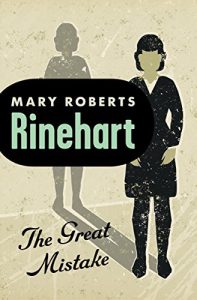
The Great Mistake
In the mystery series “Death on Demand”, by Carolyn Hart, several women authors of the golden age are mentioned: Agatha Christy, Ngaio Marsh, Dorothy Sayers, Margery Allingham, and our own Mignon Eberhart. But one author I’d never heard of was Mary Roberts Rinehart. So when an e-book edition of The Great Mistake, one of her titles, popped up on BookBub, I bought it.
And I wasn’t disappointed. Set in a small town called Beverly set near Town, it is large enough to have a hunt club, and Society. After some digging online, I discovered the book was published in 1940, but nothing of World War II, politics, or international tensions shadow this book. I was a third of the way through before I could clearly say, “well, we don’t do that anymore”. The characters are from all sections of society, and for the most part are treated very fairly. If anyone comes off looking churlish, it’s the homicide officer from Town, and of course, it’s part of his job, as the outsider. The main characters are all definitely rounded. There is a love story, but surprisingly enough for the time, it is low-key. The foundation of the mystery is built skillfully, adding to the suspense.
The main character, Pat, comes into “the big house on the Hill,” to be a secretary to the widow of the billionaire who built the house for her and her son. Maude, the widow, is a vibrant, attractive personality, and busy hostess in need of help for her parties and social responsibilities. And Pat is fond of her. Tony is the son, who runs the family firm in Town and at first they merely get on each others nerves. Pat never sets out to be a detective of any type, unlike many other main characters of mystery fiction, particularly cozy mysteries. She is meant to be more of a way for us to be a part of the mystery. The events of the story tell on her, as her employer falls mysteriously ill. Then a dear friend’s runaway & divorced husbanded returns for nursing for a terminal illness, (he says.) A mysterious figure is seen peering in a window, and a night watchman is mugged, stripped of trousers (& keys). The entire mystery is framed by remarks about writing the entire story down for everyone, which serves as a fine way to find out how the dangling threads are tied up. It all flows so well, the language enhances the story and never shouts out the time period. A smoother read in that regard than Christie.
Mary Roberts Rinehart, (August 12, 1876-September 22, 1958) was often called the American Agatha Christie. While she is considered the source of the phrase “the butler did it”, from her novel The Door, 1930, the writer never used that phrase in the book. She is also considered to have invented the “Had-I-But-Known” school of mystery writing in her book The Circular Staircase, 1908. She wrote novels, plays, short stories, travelogues, and was a war correspondent. With her sons she founded the publishing house Farrer & Rinehart, and served as director.
More about Mary Roberts Rinehart and lists of her titles from Wikipedia
Friday Reads: Hillbilly Elegy by J.D. Vance
Far away from bike paths that lead to grocery stores that sell kale is Appalachia. It runs through West Virginia and eastern Kentucky, and some parts of Tennessee and the Carolinas, too. It’s mostly dirt-poor and the things for which it’s known—family feuds, coal mining, moonshine—seem to have little connection with modern life in other parts of America. These days, unless Appalachia is being mocked, it’s generally ignored.
Which is why it’s strange that this memoir has struck such a chord. It has been sitting atop the bestseller lists for months and has received coverage in tons of major media outlets. On its face, the story doesn’t seem to be widely relatable. J.D. Vance’s family originated in the hills and hollers of rural eastern Kentucky. He experienced the traumas that often shadow poor communities: drug abuse, outbursts of violence, and other self-defeating behaviors. But, unlike many, Vance escaped and prospered, eventually attending Yale and joining a San Francisco investment firm. Hillbilly Elegy reads like a gateway into the world of “Bloody Breathitt” County, Kentucky. But it also details the process through which Vance found a better life outside the region. The book is interesting as a depiction of an overlooked place, but it also works as a coming-of-age story.
And it’s getting talked up as a kind of Rosetta Stone that explains election results. The Times calls it “a civilized reference guide for an uncivilized election”. I’m not sure that I totally buy that. Appalachia is a pretty unique place. I don’t know how much you can port over its attributes to cities in the Rust Belt and so on. It’s worthwhile to examine a culture and community for its own sake, but if you’re just looking for national power brokers or explanations for electoral trends, Hazard, Kentucky might not be where you want to start.
Even if Hillbilly Elegy can’t provide pat answers to complex political questions, it’s still a good book that’s very affecting and ultimately inspiring. If you would like to learn more about the region, I’d recommend this book, as well as two documentaries. American Hollow focuses on the same area and lifestyle described in Hillbilly Elegy and Oxyana viciously captures the prevalence of drug addiction in Appalachian communities. It’s great that attention is being drawn to a part of our country that’s often been forgotten—hopefully, it will lead to some real change for the region.
Vance, J. D. (2016). Hillbilly elegy: a memoir of a family and culture in crisis. New York: Harper.
Friday Reads: Storm Front by Jim Butcher
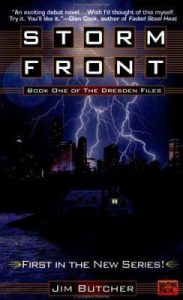 Somewhere in Chicago right now there is a wizard named Harry Dresden. You might know him because he is the only professional wizard listed in the phone book: “Lost items found. Paranormal Investigations. Consulting. Advice. Reasonable Rates. No Love Potions, Endless Purses, or Other Entertainment”. If you ever run into a werewolf, vampire, demon or other nasty creature of the night he is your man! Just don’t ask him to perform at your son’s birthday party because he is not a magician. That you would think that is just offensive.
Somewhere in Chicago right now there is a wizard named Harry Dresden. You might know him because he is the only professional wizard listed in the phone book: “Lost items found. Paranormal Investigations. Consulting. Advice. Reasonable Rates. No Love Potions, Endless Purses, or Other Entertainment”. If you ever run into a werewolf, vampire, demon or other nasty creature of the night he is your man! Just don’t ask him to perform at your son’s birthday party because he is not a magician. That you would think that is just offensive.
Jim Butcher knows Harry the best. There is rumor that Harry is merely a product of Butcher’s imagination, but I refuse to believe that bit of blasphemy. I also believe in fairies and nothing you say or do will ever erase the twinkle from my eye.
In any case, Jim Butcher has written a series of books called The Dresden Files detailing some of the more notable events from Harry’s life. The first book in the series is Storm Front where we learn that “just because you are paranoid doesn’t mean there isn’t an invisible demon about to eat your face”. Sage advice. I must take moment here to point out that I have grown rather fond of my face and must thank Mr. Dresden for taking on said demon. My face thanks him.
I also highly recommend listening to the audiobook version of The Dresden Files because James Marsters is magical. Just in case you didn’t know this bit of trivia, James Marsters played Spike in Buffy the Vampire Slayer. When I heard Mr. Marsters as Harry I am pretty sure I swooned and melted. In that order. I was a full on puddle by the middle of the first book.
You may not be aware, but this review is in real danger of turning into a fangirl rave. But I am a professional so I will just say that Harry Dresden is a clever private investigator who likes to break tension with a perfectly timed one-liner that will have you tittering into your morning latte. If you like fantasy, P.I. stories, or have grown accustomed to your face, you will love Harry Dresden. Happy reading!
Butcher, Jim. Storm Front. Penguin, 2000.
Friday Reads: Our Souls at Night by Kent Haruf
 At the 2017 Screen Actors Guild Awards, Viola Davis said the following upon accepting her award for Outstanding Performance by a Female for the movie Fences: “What August (Wilson) did so beautifully is he honored the average man …and sometimes we don’t have to shake the world and move the world and create anything that is going to be in the history book. The fact that we breathed and lived a life … means that we have a story and it deserves to be told.” I think writers who choose ordinary subjects can tell amazing stories. I think this is Kent Haruf’s talent–to tell everyman’s story, the story of those people we all know and recognize, who live next door if not in our own home.
At the 2017 Screen Actors Guild Awards, Viola Davis said the following upon accepting her award for Outstanding Performance by a Female for the movie Fences: “What August (Wilson) did so beautifully is he honored the average man …and sometimes we don’t have to shake the world and move the world and create anything that is going to be in the history book. The fact that we breathed and lived a life … means that we have a story and it deserves to be told.” I think writers who choose ordinary subjects can tell amazing stories. I think this is Kent Haruf’s talent–to tell everyman’s story, the story of those people we all know and recognize, who live next door if not in our own home.
Our Souls at Night was Haruf’s last novel before his death in 2014, and it takes place in the fictional town of Holt, Colorado, a small town created for three of his other novels. Addie Moore and Louis Waters have both lost their partners and have lived a long time in Holt knowing of each other rather than being well acquainted. One day, Addie pays a visit to Lois and asks: “I’m wondering if you would consider coming to my house sometimes to sleep with me … I mean we’re both alone. We’ve been by ourselves for too long. For years. I’m lonely. I think you might be too. I wonder if you could sleep in the night with me. And talk … I’m not talking about sex, I’m talking about getting through the night … the nights are the worst don’t you think?” And this is where their story begins as this invitation turns into many evening conversations and the revelations of life, regrets, and love lost. It confirms how grief needs to be shared with others especially those for whom the loss is similar. When two people form a bond, onlookers will have opinions and often, not so quietly. I could relate to the gossipy town conversations that made me forever choose to live in a city with a population of at least 100,000 or more.
This is a spare read with uncomplicated and honest characters. There is a cadence to Haruf’s books – small town living and the daily minutia that are both familiar and regular. The conversations are ones you’ve had yourself. Spending time in Holt is downshifting to rural America; slowing down and looking people in the eye when you walk past them on the street.
A movie adapted from this book will be released sometime this year, starring Robert Redford and Jane Fonda, who first appeared together in 1967’s Barefoot in the Park. This will be quite a contrast.
Friday Reads: The House of the Spirits
I first read Isabel Allende’s The House of the Spirits my junior year of high school. At the time, I was taken with the elements of magical realism that permeated the story. In the twenty years since, I have lost track of the number of times I have read this book. Each time, I gain new insight into this complex, multi-generational novel.

Set in Chile, against the backdrop of social and political upheaval, Allende focuses on the ever-changing fortunes of Esteban Trueba, his wife, Clara del Valle and their children: Blanca, Jaime and Nicolas. While Esteban concentrates on accumulating wealth and power, Clara endeavors to strengthen her clairvoyant talents. Since childhood, Clara has been able to move objects and predict future events, such as the deaths of her older sister and parents. Although Clara cares for her husband, she leads an independent life because she abhors his conservative values. Following their mother’s lead, the children, and later Esteban’s green-haired granddaughter, become swept of up in the socialist revolution and subsequent military coup.
Despite its dark themes, The House of the Spirit is a story of hope and survival. Allende’s characters often experience the worst, but retain an innate sense of right and wrong. Until the bitter end, they continue to believe in the basic goodness of mankind. The last time I read The House of the Spirits, I realized that despite the horrors she had just experienced, Esteban’s granddaughter continues to hope for a better tomorrow. Following her imprisonment, she encounters a woman whose spirit remains strong regardless of efforts to destroy it. Alba, whose name is Spanish for dawn, knows the conservative regime will end and life in Chile will improve for everyone.
Allende, Isabel. The House of the Spirits. Translated by Magda Bogin. New York: Alfred A. Knopf, 1985.
Friday Reads: How to Survive a Plague: The Inside Story of How Citizens and Science Tamed AIDS, by David France
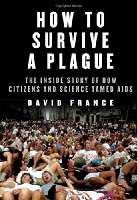 After watching Dallas Buyers Club several years ago, I wanted to learn more about the early treatment challenges that caused people with AIDS to criticize and bypass the FDA’s slow-moving and bureaucratic drug approval process. This led me to a copy of Randy Shilts’ classic 1987 book, And the Band Played On, which covered the AIDS epidemic through 1985. I hesitated to start it, however, because of the 25+ years of subsequent developments that wouldn’t be covered, including significant advances in treatment options in the mid-90s. So when David France’s How to Survive a Plague: The Inside Story of How Citizens and Science Tamed AIDS showed up on the New York Times “100 Notable Books of 2016” list, I jumped on it!
After watching Dallas Buyers Club several years ago, I wanted to learn more about the early treatment challenges that caused people with AIDS to criticize and bypass the FDA’s slow-moving and bureaucratic drug approval process. This led me to a copy of Randy Shilts’ classic 1987 book, And the Band Played On, which covered the AIDS epidemic through 1985. I hesitated to start it, however, because of the 25+ years of subsequent developments that wouldn’t be covered, including significant advances in treatment options in the mid-90s. So when David France’s How to Survive a Plague: The Inside Story of How Citizens and Science Tamed AIDS showed up on the New York Times “100 Notable Books of 2016” list, I jumped on it!
David France is an investigative reporter who has been covering AIDS since the early 1980s. He moved to New York City in June 1981, immediately after graduating from college and just weeks before a headline in the July 3 New York Times proclaimed “Rare Cancer Seen in 41 Homosexuals.” This put France at a major epicenter of the epidemic from its opening days—and from the very outset of his adult life. It is this embedded perspective that gives an intense intimacy to what is also a thoroughly researched and gripping account of the gay community’s mobilization to political and scientific activism and advocacy.
Although death and dying pervade France’s narrative, there is hope and inspiration in the formation of groups like Gay Men’s Health Crisis, ACT UP, with its rallying cry of “Drugs into bodies,” and TAG (Treatment Action Group). Members with an affinity for research, though lacking scientific background and in some cases without college degrees, educated themselves on the inner workings of government health agencies like the FDA, CDC, and NIH, and became experts on immunology and virology. This allowed them to challenge and ultimately collaborate as partners with a medical establishment used to patients passively accepting whatever treatment options were prescribed. They were able to press for an accelerated drug approval process, modifications in clinical trial protocol, reductions in drug costs, and more.
France’s account traces drug development through the January 1996 annual Conference for Retroviruses and Opportunistic Infections, where breakthrough results of two clinical drug trials were reported, heralding the arrival of new treatment options supporting long term survival of people with AIDS. Finally, AIDS no longer equaled death! While this is a victorious point at which to conclude his story, a happily-ever-after ending would have been inappropriate, and France avoids one with the final words of his final chapter: “It was not over. It would never be over. But it was over.” His epilogue also bears witness to the toll the plague took on surviving activists, often in the form of depression, drug addiction, underemployment and unemployment. Not only had they lost so many friends and lovers, they were now set adrift without purpose in a life they hadn’t prepared for, because they never expect to live to see it.
Although I still plan to read Shilts’ And the Band Played On, I’m glad I started with David France’s book; it provided me with the education I was looking for, in a compelling and thorough manner. If you’re interested in this topic but don’t want to tackle a 600+ page book (either Shilts’ or France’s), you may want to consider watching the 2012 documentary written and directed by France, also titled How to Survive a Plague. It is currently available to stream on Netflix.
France, David. How to Survive a Plague: The Inside Story of How Citizens and Science Tamed AIDS. New York: Knopf, 2016.
Friday Reads: The Goldfinch: A Novel by Donna Tartt
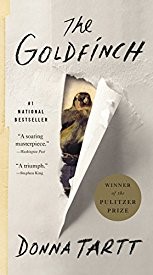 Donna Tartt’s The Goldfinch, published in 2013, was awarded the 2014 Pulitzer Prize for Fiction. I had read reviews and commentaries about the book, looked it over in a bookstore, and considered borrowing or buying a copy. I resisted because I was daunted by its length – the hardcover edition is 760 pages. I recently found a paperback copy in a Colorado library on the books for sale shelves. For a two dollar contribution to the library’s friends group the book was mine. It’s the second longest book I’ve ever read and it was a long haul, but a good one. During the course of reading it I also borrowed from Lincoln City Libraries the excellent digital audiobook version.
Donna Tartt’s The Goldfinch, published in 2013, was awarded the 2014 Pulitzer Prize for Fiction. I had read reviews and commentaries about the book, looked it over in a bookstore, and considered borrowing or buying a copy. I resisted because I was daunted by its length – the hardcover edition is 760 pages. I recently found a paperback copy in a Colorado library on the books for sale shelves. For a two dollar contribution to the library’s friends group the book was mine. It’s the second longest book I’ve ever read and it was a long haul, but a good one. During the course of reading it I also borrowed from Lincoln City Libraries the excellent digital audiobook version.
The Goldfinch begins with a terrorist act – a bomb explosion in New York City’s Metropolitan Museum of Art – and the resulting tragic destruction and loss. What follows is an evolving mystery about a missing painting – a Dutch masterwork called The Goldfinch. Included are theft, drugs, the art black market, the craft of antique furniture restoration, and the complex relationships among family, friends, friends of friends, swindlers, and much more. Art, in many forms, is central to the book. The characters are vivid, the settings are rich in detail, and the plot pulls the reader along toward a surprising end. For me, it is the kind of book you don’t necessarily want to come to an end.
Stephen King, in a New York Times Book Review commentary, said “The Goldfinch is a rarity that comes along perhaps half a dozen times per decade, a smartly written literary novel that connects with the heart as well as the mind…..” Donna Tartt has also written the novels The Secret History and The Little Friend.
Tartt, Donna. The Goldfinch: A novel. New York: Little, Brown and Company. 2013.
Friday Reads: “Born to Run” by Bruce Springsteen
 When a fan approaches the autobiography of a rock star, the bar is set pretty high. And with Bruce Springsteen’s Born to Run, I thought the high bar was reached and sailed over. I didn’t really know what to expect. I always thought the real Bruce was probably a combination of the characters that shine out from his songs, but of course that’s an oversimplification. The character that comes off the pages of this book does have a lot in common with the characters that are seen in the narratives in his music. But Bruce Springsteen is a multi-layered guy and he is complicated. He is the real deal, for sure. He came up on the streets of New Jersey and early Greenwich Village, and his reflections on those early days (and what came later) take the reader into a slice of America that goes well beyond voyeuristic star gazing. When he says, “The grinding hypnotic power of this ruined place and these people would never leave me,” (in reference to his hometown) you can bet it won’t be leaving the reader soon either.
When a fan approaches the autobiography of a rock star, the bar is set pretty high. And with Bruce Springsteen’s Born to Run, I thought the high bar was reached and sailed over. I didn’t really know what to expect. I always thought the real Bruce was probably a combination of the characters that shine out from his songs, but of course that’s an oversimplification. The character that comes off the pages of this book does have a lot in common with the characters that are seen in the narratives in his music. But Bruce Springsteen is a multi-layered guy and he is complicated. He is the real deal, for sure. He came up on the streets of New Jersey and early Greenwich Village, and his reflections on those early days (and what came later) take the reader into a slice of America that goes well beyond voyeuristic star gazing. When he says, “The grinding hypnotic power of this ruined place and these people would never leave me,” (in reference to his hometown) you can bet it won’t be leaving the reader soon either.
This book was written over seven years in several drafts and redrafts. Springsteen likens the process of writing the book to song-writing. That comparison isn’t lost on this reader. He writes the book in the same cool, clean voice that brought us “In the day we sweat it out on the streets of a runaway American dream / At night we ride through the mansions of glory in suicide machines.” The pages of this book ring just as true as the lyrics to the Springsteen songs that this fan listened to over and over on a front porch in Nebraska on hot summer nights.
I was also struck by the fact that for an autobiography there is a ton of rich, juicy detail about the others on this journey with him. His family is finely drawn and very interesting. And there is lots of intel on the cast of characters that made up his bands through the years. For me, Stevie Van Zandt (think stellar musician and one of the central members of the Sopranos cast) and the late sax great Clarence Clemons are tremendously compelling characters that really help paint the picture of Springsteen. Knowing more about his close relationships really rounds out the reader’s understanding of who “The Boss” really is. You’ll love this book if you ever sang along to “We gotta get out while we’re young / `Cause tramps like us, baby we were born to run.” Even if you didn’t, this autobiography is worth your time.
Review by Mary Jo Ryan
#FridayReads
Born to Run by Bruce Springsteen
Simon & Schuster, 2016
Friday Reads: League of Denial
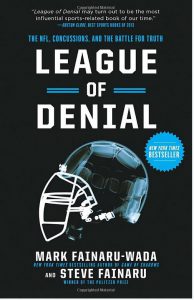 Let me say up front (gasp!) that I am not a football fan. Not one bit. OK, I admit that at a time in my life long ago I might become moderately interested in seeing a good game (and rooting for the underdogs), but in today’s day and age I have little interest. I read the bulk of League of Denial by Mark Fainaru-Wada and Steve Fainaru while hanging out in airports and on airplanes during a recent trip. Before getting into the content of League of Denial, it might be beneficial to describe the authors’ backgrounds, as well as why these brothers have different last names (including the origin of the hyphen). Steve Fainaru is an award winning reporter for the Washington Post (known for his field reporting in Iraq). His brother Mark (he hyphenated his name with that of his wife’s) has a background in sports reporting for the San Francisco Chronicle, worked on the BALCO steroids reporting (subsequently co-authoring Game of Shadows), and is a current investigative reporter for ESPN.
Let me say up front (gasp!) that I am not a football fan. Not one bit. OK, I admit that at a time in my life long ago I might become moderately interested in seeing a good game (and rooting for the underdogs), but in today’s day and age I have little interest. I read the bulk of League of Denial by Mark Fainaru-Wada and Steve Fainaru while hanging out in airports and on airplanes during a recent trip. Before getting into the content of League of Denial, it might be beneficial to describe the authors’ backgrounds, as well as why these brothers have different last names (including the origin of the hyphen). Steve Fainaru is an award winning reporter for the Washington Post (known for his field reporting in Iraq). His brother Mark (he hyphenated his name with that of his wife’s) has a background in sports reporting for the San Francisco Chronicle, worked on the BALCO steroids reporting (subsequently co-authoring Game of Shadows), and is a current investigative reporter for ESPN.
League of Denial details the NFL’s concussion crisis. It describes the first players that were diagnosed (post-mortem) with chronic traumatic encephalopathy (CTE), a progressive degenerative disease that had previously only been identified in boxers or other persons that suffered repeated blows to the head. League of Denial chronicles a number of former NFL players who suffered from the effects of CTE, from their playing days to their life struggles after retirement. The first former player to be diagnosed with CTE was Pittsburgh Steeler hall of fame center Mike Webster. Webster’s story is interesting because his life is illustrative of the struggle that many former players go through during and after their days in the NFL. It’s a very sad story. League of Denial chronicles Webster’s retirement financial troubles, living out of his truck, addiction to various prescription medications, and the fact that he often couldn’t sleep unless a friend hit him with a Taser, rendering him incapacitated for brief periods of time. To illustrate, this interview, taken from the PBS Frontline documentary (titled League of Denial) shows the depth of his brain injury, as well as the struggle of former NFL safety Gene Atkins.
Then there are the suicides. A number of these former players that committed suicide were diagnosed with CTE afterward. League of Denial describes some of these, including Terry Long (45 years old, drank antifreeze), Dave Duerson (50 years old, shot himself in the chest and left a note indicating that he wanted his brain to be used for research), and Junior Seau (43 years old, another gunshot to the chest). League of Denial has a bit of it all, including intrigue, mystery, and cover-ups. A land where NFL doctors argue with independent ones, former players fight for disability payments, and the NFL (by far the leader in worldwide sports revenues fights to maintain its image (among fans, players, and moms). A lot of parallels exist between the NFL concussion crisis and the tobacco industry, and many of the league insiders have called for a different handling of the crisis by the NFL, which up until recently denied any link between football’s inherent traumas to the head and CTE. Dr. Ann McKee, longtime Packers fan and professor of Neurology & Pathology at Boston University, aptly sums things up by saying:
“Football is an American sport. Everyone loves it. I certainly would never want to ban football. . . . We haven’t banned cigarette smoking. People smoke. People make that choice. But they need to make an informed decision. They need to understand the risks and it needs to be out there if they want to pay attention to what those risks are.”
I would recommend this book, even though Ann is wrong about everyone loving football. It is an easy read and informative, whether you are a fan or not a fan, and the science surrounding the concussion crisis is presented in an interesting way.
Friday Reads: The Strange Library by Haruki Murakami
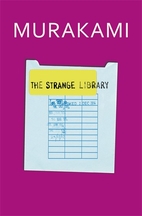 Because Haruki Murakami’s birthday was yesterday, and because this is a library blog, this week I’ve chosen to write about The Strange Library by Haruki Murakami. While this is available as an audio book, I must recommend the Knopf print edition if you are able to read that instead. The book design is by Chip Kidd, and it’s lovely. The cover alone references the narrative in several creative ways, and the illustrations within the book are plentiful and thoughtful.
Because Haruki Murakami’s birthday was yesterday, and because this is a library blog, this week I’ve chosen to write about The Strange Library by Haruki Murakami. While this is available as an audio book, I must recommend the Knopf print edition if you are able to read that instead. The book design is by Chip Kidd, and it’s lovely. The cover alone references the narrative in several creative ways, and the illustrations within the book are plentiful and thoughtful.
The art design struck me even more as a vehicle for the story, a vehicle almost approaching a translation of the story, because of a recent article about Murakami. If you’re interested in Murakami, you should read “The Murakami Effect” by Stephen Snyder, which appeared on Literary Hub on 01/04/2017. You may agree or disagree with the writer’s arguments (here’s a clue to its contents: the subtitle is “On the Homogenizing Dangers of Easily Translated Literature”), but reading a critique of the translation of Murakami’s work does give you an insight into how the author structures his works. Murakami does not write about complicated ideas as much as he juxtaposes unexpected, easily visualized entities and actions, which allow the reader to fill in the complicated ideas themselves, around those entities and actions. This happens to make him very easy to translate—or, he writes this way because it’s easy to translate, according to Snyder.
I have more of an appreciation for Murakami after reading the Lithub article, which may not have been the author’s intent. Snyder attempts to take some wind out of the literary sails of Murakami’s reputation, comparing him to other Japanese writers (like Minae Mizumura, whom you might want to learn more about) and finding him, in the end, pop.
But I like pop. Murakami is nuanced enough to be quality while being accessible. And letting the reader draw some conclusions is one of my favorite things that an author can do—I love this about Flannery O’Connor, for example. It is important, though, not to take Murakami’s work as any sort of object lesson about Japanese life, just as we can’t expect to learn all we need to know about the South from O’Connor. This is another point in Snyder’s article—how Americans see Murakami’s writing as synecdochical for all things Japanese, overwriting reality with a magic key they think they learned from some magical realist novels. Readers need to try to be smarter than that, and I think we can be.
The Strange Library is a quick read—for a less marketable author, this would have just been a short story in a magazine. So hipster grad students won’t be able to carry it around as long as they can carry around their copies of 1Q84… but it’s a good introduction to Murakami if you’ve been interested and yet haven’t taken the leap. And you know you want to read a book called The Strange Library. And yes, that’s all I’m going to tell you about the actual text.
Fun facts about Haruki Murakami: not related to writer Ryu Murakami (whom I recommend if you want something grittier) or artist Takashi Murakami (if you want something even more pop). And if there’s anything more precious, predictable, and yet still enjoyable, than a McSweeney’s humor piece about Haruki Murakami, I don’t know what it would be, so here that is.
Murakami, Haruki, and Ted Goossen. The Strange Library: 107. , 2014. Print.
Friday Reads: Star Wars: Bloodline
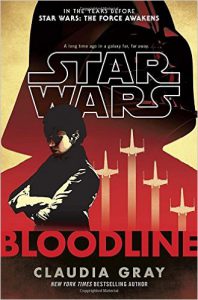 I am a member of the original Star Wars trilogy generation. My parents took me and my sister to see Star Wars in the theater in 1977, before it was IV, before it had a subtitle.
I am a member of the original Star Wars trilogy generation. My parents took me and my sister to see Star Wars in the theater in 1977, before it was IV, before it had a subtitle.
Along with all fans, I was devastated by the sudden death of Carrie Fisher. Her portrayal of the strong, independent, powerful rebel, Princess Leia, was an inspiration to pre-teen me.
From their first encounter, when I saw Leia stand up to the hulking Darth Vader, I was hooked. So, when I heard that a new Star Wars book was coming out last year that focused on Leia, I had to have it. And I wasn’t disappointed.
Star Wars: Bloodline, by Claudia Gray, is part of the new series of novels that are being published in conjunction with the new films and TV shows.
When Disney purchased Lucasfilm in 2012, all of the Star Wars books and comics that had been previously written were declared non-canon by Disney, meaning that those stories were no longer the history of the Star Wars world. Instead, Disney is publishing new books that will bring the storytelling in the new movies into continuity with the older ones.
Bloodline takes place between Return of the Jedi and The Force Awakens. It is a fast-paced novel, full of espionage, planet jumping, and clandestine missions. Yes, the Rebellion defeated the Empire at the end of Return of the Jedi. But unfortunately, that did not bring peace to the galaxy. Politics and in-fighting is undermining the New Republic Senate, of which Leia is a member. But, her investigations into criminal activities related to the problems in the Senate lead her to determine that something much bigger is going on.
In addition to being an engrossing story about Senator Leia and her young team of followers as they track down this new threat to the Republic, Bloodline provides some important context for The Force Awakens and future films. It reveals the beginnings of the formation of the Resistance and the origins of the First Order.
And you’ll also discover where Leia earned the awesome title ‘Huttslayer’. Killing a crime lord with the chain keeping you his slave can earn you big points with certain parties.
Friday Reads: All Rise for the Honorable Perry T. Cook by Leslie Connor
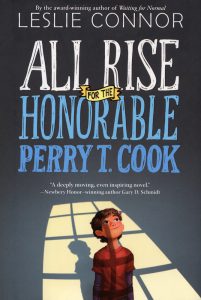 Perry, age 11, was born and has lived all his life with his mother in the fictional Blue River Co-ed Correctional Facility in Surprise, Nebraska, thanks to the current warden pretending he isn’t there. Then the new district attorney, Tom VanLeer, living in a nearby town, discovers his existence and “rescues” him from his mother and friends by bringing him home and becoming his foster family with his wife and his step-daughter, Zoey. Zoey is Perry’s best friend at school.
Perry, age 11, was born and has lived all his life with his mother in the fictional Blue River Co-ed Correctional Facility in Surprise, Nebraska, thanks to the current warden pretending he isn’t there. Then the new district attorney, Tom VanLeer, living in a nearby town, discovers his existence and “rescues” him from his mother and friends by bringing him home and becoming his foster family with his wife and his step-daughter, Zoey. Zoey is Perry’s best friend at school.
For his class project, Perry decides to write the story of several inmates, who are his friends, and who agree to be interviewed. Regret for what they, including Perry’s mother Jessica, had done and how they have changed and are working toward parole, staying positive as much as possible, all send a different message than one might expect from prisoners. There are a few negative people incarcerated there, and Perry keeps his distance from them.
District Attorney Tom VanLeer is certain his approach is the right one, even as he delays Jessica’s parole hearing, believing she is guilty of making her son suffer in prison. Zoey finds some of her stepfather’s viewpoints and habits condescending and irritating. She and Perry also find their new situation, as foster brother and sister, rather problematic.
Perry is a wonderful character, with a positive viewpoint and an understandable confusion about things he has never encountered before, such as how to make the bathtub become a shower. His upbringing in the correctional facility has prepared him to give others a chance, and to challenge Tom VanLeer on his misconceptions. Other characters are well-developed and offer additional viewpoints as to how things can go terribly wrong and hopefully be forgiven. A terrific choice for grades 5-8 as well as adults.
Friday Reads: The Fireman by Joe Hill
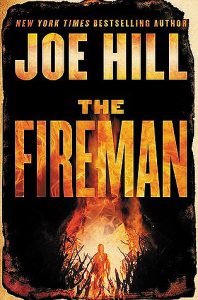 A fast-moving plague has set the world ablaze, quite literally. The “Dragonscale” spore marks its hosts with intricate tattoo-like patterns, which just happen to also cause them to spontaneously combust. Whole cities watch in terrors as their inhabitants burn to death, no cure in sight. To protect themselves, some citizens band together into “cremation squads” and hunt down those carrying the disease.
A fast-moving plague has set the world ablaze, quite literally. The “Dragonscale” spore marks its hosts with intricate tattoo-like patterns, which just happen to also cause them to spontaneously combust. Whole cities watch in terrors as their inhabitants burn to death, no cure in sight. To protect themselves, some citizens band together into “cremation squads” and hunt down those carrying the disease.
Before the local hospital ignited, Nurse Harper cared for the infected in her New Hampshire town. She and her husband Jakob made a pact to kill themselves if they ever caught the spore. Now Harper’s on the run from the cremation squads and Jakob, having discovered her own dragonscale markings… and her pregnancy.
This is the second book by Joe Hill I’ve read, the first being NOS4A2 (which I loved). It lived up to my expectations, and I will seek out more of his work. It wasn’t until I finished this book that I realized that Joe is the son of Stephen King, writing under a pseudonym so that his writing could stand on its own merit (which it does). If you’re in the mood for a fast-paced horror/thriller novel, this is it!
Friday Reads – Alton Brown: EveryDayCook
Cold Brew Coffee! Fish Sticks and Custard! Midnight Mug Cake!
I’ve loved Alton Brown since watching his show Good Eats on Food Network (as well as Iron Chef America and Cutthroat Kitchen). His cookbooks are always fun to read as he offers commentary on the science behind the ingredients, humorous insight on why he likes a particular recipe, or some history of each dish.
These 101 recipes include his personal favorites or things he eats on a daily basis “from morning to late and night and everywhere in-between.” Recipes are arranged by the time of day: Breakfast, Coffee Break, Noon, Afternoon, Evening, Anytime, and Later. Recipes range from classics, such as meatloaf or peanut butter cookies, to new twists with EnchiLasagna (enchilada + lasagna).
Separate sections are included that focus on pantry basics and kitchen tools. He explains his methodology within these sections and throughout the different recipes which I thought was fascinating. One note to point out, if you don’t have a kitchen scale, is that he does use both cups and grams in different recipes. For the few specialized kitchen tools, he does offer explanations and alternatives which is always helpful. If nothing else, check it out for the pictures (which were all taken on his iPhone). The food looks gorgeous.
Brown, A. (2016). Alton Brown: EveryDayCook. New York: Ballantine Books.
Friday Reads; The Invisible Library by Genevieve Cogman
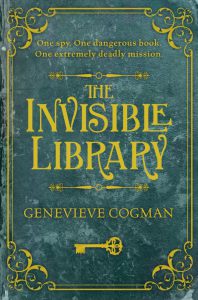
The Invisible Library
Irene is a librarian, a junior librarian of The Invisible Library, which spans alternative worlds and saves and secures copies of unique books. She answers to a senior librarian, much older & more experienced, and unable to leave the library to secure texts for the library. She’s not unique except that both her parents are librarians, as well. She isn’t 007. She knows she has a lot of experience to gain yet, and one of those experiences she needs to face is training an apprentice. And the time has finally come. Her first trainee is Kai, a tall, dark, beautiful young man of mystery. And their first mission together is nearly stolen by a competitor of Irene’s.
The world they enter is a clockwork world of 1890 era, but also infected with “chaos”, meaning that there are creatures of magic and legend at work here. The most chaotic of them all are the Fae, personified in Lord Silver, a diplomat. The book they were to take, has already been stolen, but it’s unclear who’s done the deed–a famous catburgler who may have killed the new owner, or a cult of clockwork engineers who are anti-magic (the deceased was a vampire.) The waters are further muddied by the “great detective”, who has a better relationship with the local police than S.H. And a particularly frightening rogue librarian that was once one of the library’s greatest librarians.
The characters are wonderful, Irene is someone you will want to read about–whether she’s running from granite gargoyles or escaping from cyborg crocodilians. And unlike 007, she’s often wondering why she can’t just have a nice screaming fit, oh yes, that’s right, she has to get herself out of this. Whatever this is. Kai has his secret, which I won’t reveal, but he is young, and while handy to have around, he’s still learning. Irene and other librarians have the ability to use “the Language”, to open, close, manipulate objects, and to a certain limit, people. It’s a sort of World re-arranging type of magic, rather than the chaotic brand that the Fae use. Kai has his own talents.
The world building is excellent. Just when you think, oh, yes, I’ve seen this, something new happens, a mini zeppelin takes off from the roof of the British Museum, headed for the British Library. Or at Lord Silver’s ball, when Irene’s just about to get information about the book they are after, her competition strolls in, wearing a stunning Worth gown, with an adoring pack of men. But you’ll have to read it yourself! I’m waiting for the sequel, The Masked City.
Friday Reads: Lives of the Monster Dogs by Kirsten Bakis
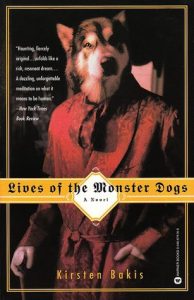 A Prussian mad scientist relocates to rural Canada, where he uses his mad science skills to create “monster dogs”. The dogs’ intelligence is boosted. Instead of paws, they have prosthetic hands on their forelegs, and implanted voice boxes allow the dogs to speak. They can also walk upright, although some need to use canes for support. Despite these enhancements, the dogs are treated as virtual slaves in their isolated town—so isolated that it retains the scientist’s 19th-century Prussian culture—until the beasts finally revolt. In 2008, the monster dogs arrive in Manhattan, wearing top hats and white ties. Their new city welcomes them and things finally seem to be looking up for the dogs, but a new threat could endanger their entire existence.
A Prussian mad scientist relocates to rural Canada, where he uses his mad science skills to create “monster dogs”. The dogs’ intelligence is boosted. Instead of paws, they have prosthetic hands on their forelegs, and implanted voice boxes allow the dogs to speak. They can also walk upright, although some need to use canes for support. Despite these enhancements, the dogs are treated as virtual slaves in their isolated town—so isolated that it retains the scientist’s 19th-century Prussian culture—until the beasts finally revolt. In 2008, the monster dogs arrive in Manhattan, wearing top hats and white ties. Their new city welcomes them and things finally seem to be looking up for the dogs, but a new threat could endanger their entire existence.
If this synopsis sounds appealing, you should probably read this book. The imaginative premise is definitely the best thing about it. The blend of walking, talking dogs and their old-fashioned Germanic manners is very compelling, and at times this novel has an almost steampunk-like feel. The author skillfully merges the fantastic and the antique, especially in elements like the dogs’ opera libretto, which tells the story of their Canadian uprising.
But there are a few slip-ups. Some of the narration is handled by Cleo Pira, a young writer whom the dogs befriend. Cleo is not an especially interesting character and her adoption by these fascinating dogs seems kind of Twilighty. Sometimes she talks a lot about clothes instead of the talking, walking dogs that wear them. Additionally, some of the plotting is overly loose and the ending seems a bit abrupt and unsatisfying.
But, for me, the monster dogs made up for it. It’s a very audacious idea for a story and, even if everything doesn’t gel perfectly, this is certainly a memorable read. This book was published almost twenty years ago and it is, to date, the author’s only novel. It seems to have gone unnoticed, so here’s hoping that it eventually finds an audience that can appreciate its charms.
Bakis, K. (1997). Lives of the monster dogs: A novel. New York: Warner Books.
Friday Reads: The Tenth Man: A Novel, by Graham Greene
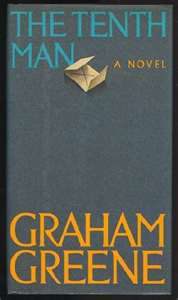 One advantage I have had over the years with the Nebraska Library Commission is that of being able to visit libraries all over the state – primarily public libraries, but a few other types as well. Often the public libraries have ongoing book sales of both weeded and donated books, usually on a shelf or sale table with suggested prices for paperback, hardbacks, or magazines, sometimes with statements such as, “Donation accepted.” On one fairly recent swing through the western part of the state to do a strategic planning workshop, I paused briefly at a book sale and purchased The Tenth Man, a short novel by Graham Greene.
One advantage I have had over the years with the Nebraska Library Commission is that of being able to visit libraries all over the state – primarily public libraries, but a few other types as well. Often the public libraries have ongoing book sales of both weeded and donated books, usually on a shelf or sale table with suggested prices for paperback, hardbacks, or magazines, sometimes with statements such as, “Donation accepted.” On one fairly recent swing through the western part of the state to do a strategic planning workshop, I paused briefly at a book sale and purchased The Tenth Man, a short novel by Graham Greene.
Of course it was the author’s name that intrigued me, and the recollection of a film based on one of his novels, The Third Man, that caught my attention since I had never heard of a book by him entitled, The Tenth Man (and since the title so closely resembled the more well-known one). A summary of the novel itself is fairly easy and straightforward. The setting is a German prison camp during the World War II era in which political prisoners are forced to draw lots to determine which of every ten men will be executed – a “decimation” order that is apparently similar to what happened in Spain during its Fascist years.
This short novel (about 30,000 words) moves quickly, with the action and dialog quite spare, yet effective. The primary story concerns that of a wealthy attorney who is among the prisoners and who draws one of the marked papers indicating he will be executed (following orders of the prison masters who allow the prisoners themselves to determine who will be sacrificed). The crux of the story is that the attorney desperately offers all his wealth, his home and his land to any other prisoner who will take his place and be executed. He has a taker, and, being an attorney, knows how to put the proper papers together to bring this about to make the destitute man temporarily rich, at least until his death, with his family provided for.
The substitute is executed, and later, after the war has ended, the attorney returns to his former home, passing himself off with a different name and identify. He is, of course, penniless, but he is befriended by the executed prisoner’s sister and her crotchety mother, and is given caretaker-type work there since the family is in a somewhat precarious position. Yet another imposter – as it turns out, an unemployed actor — shows up, claiming to be the surviving attorney and ingratiating himself to the sister.
The story is fairly sparse, as I mentioned, but very well-written. What was most interesting to me, however, was not so much the novel itself, but more how it came about. According to the author, he wrote this novella sometime in 1944, based on an idea he had had in 1937. In 1983 Greene was contacted by an agent in America, telling him that The Tenth Man was being offered by the movie giant MGM for sale to an American publisher. Graham’s memory of the novel was so vague, that he thought he remembered writing a two-page summary of the story idea, not the 30,000 words it turned out to be. Apparently Greene had sold the rights to the novella to MGM under what he deemed a “slave contract” to ensure security for his family’s income.
Graham Greene himself worked for MI6, England’s spy agency. His travels for the agency took him all over the world, and he used many of the settings from his travels in his novels. The Tenth Man is not considered among Greene’s greatest work, but this author’s prolific career of writing novels, short stories, travel books, essays, plays and screen plays bears looking into. The Tenth Man is my introduction to an author I always meant to, but never had read, before this.
Posted in Books & Reading, General, Information Resources, Uncategorized
Tagged Friday Reads
Leave a comment
Friday Reads: American Gods, by Neil Gaiman
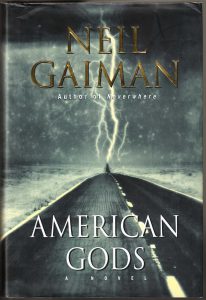 American Gods, by Neil Gaiman, is one of those books that my husband has always insisted I read, but that I’ve put off reading until now. Why am I reading it now? Because the TV show, starring Gillian Anderson and Ian McShane (among others), is set to debut in 2017, and I wanted to know the story before I watch the show.
American Gods, by Neil Gaiman, is one of those books that my husband has always insisted I read, but that I’ve put off reading until now. Why am I reading it now? Because the TV show, starring Gillian Anderson and Ian McShane (among others), is set to debut in 2017, and I wanted to know the story before I watch the show.
American Gods is the story of Shadow Moon. Sentenced to three years in prison for robbery, Shadow did his time, quietly waiting for the magic day when he could return to Eagle Point, Indiana. All he wanted was to be with Laura, the wife he deeply loved, and start a new life. But just days before his release, Laura and Shadow’s best friend are killed in an accident. With his life in pieces and nothing to keep him tethered, Shadow accepts a job from a beguiling stranger he meets on the way home, an enigmatic man who calls himself Mr. Wednesday. A trickster and rogue, Wednesday seems to know more about Shadow than Shadow does himself.
Life as Wednesday’s bodyguard, driver, and errand boy is far more interesting and dangerous than Shadow ever imagined. It is a job that takes him on a dark and bizarre road trip and introduces him to a host of weird characters whose fates are somehow mysteriously intertwined with his own.
Along the way, Shadow will learn that the past never dies; that everyone, including his beloved Laura, harbors secrets; and that dreams, totems, legends, and myths are more real than we know. Ultimately, he will discover that beneath the placid surface of everyday life, a storm is brewing, and that he is standing squarely in its path.
I listened to the 10th Anniversary full-cast audio version of American Gods, and was completely drawn in from the very beginning of the author’s introduction. Neil Gaiman actually traveled the United States while writing this story, so that he could accurately describe Shadow’s road trip on paper. Gaiman’s masterful descriptions and the actor’s performances brought this story completely to life, and I highly recommend both the book and the audio version.
Posted in Books & Reading, General, Information Resources, Uncategorized
Tagged Friday Reads
Leave a comment

